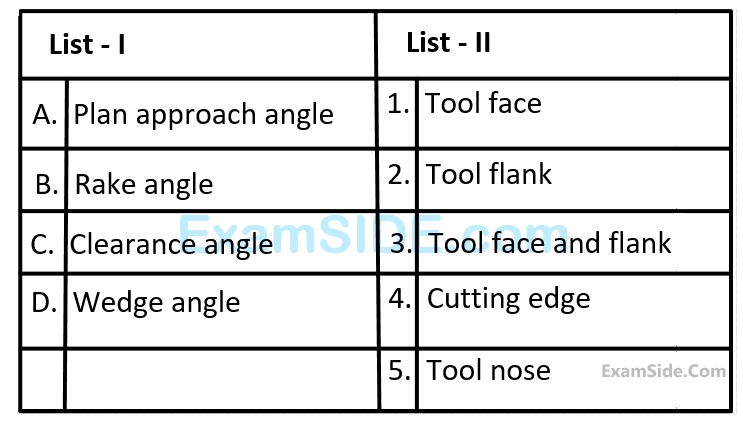GATE PI
$$M = \left[ {\matrix{ 8 & { - 6} & 2 \cr { - 6} & 7 & { - 4} \cr 2 & { - 4} & 3 \cr } } \right],$$ the value of the determinant of a matrix is


The size of the heat affected zone (HAZ) will increase with
$$1.$$ increased starting temperature
$$2.$$ increased welding speed
$$3.$$ increased thermal conductivity of the base metal
$$4.$$ increase in base metal thickness
Which of the statements given above are correct?
The magnitude of residual stresses in welding depends upon
$$1.$$ Metal melted / deposited
$$2.$$ Design of weldment
$$3.$$ Support and clamping of components
$$4.$$ Welding process used
Which of the statements given above are correct?
$$\,\,\,\,\,\,\,\,\,\,\,$$Back rake angle $$=15deg,$$
$$\,\,\,\,\,\,\,\,\,\,\,$$Width of cut $$=2mm,$$
$$\,\,\,\,\,\,\,\,\,\,\,$$Chip thickness $$=0.4mm,$$
$$\,\,\,\,\,\,\,\,\,\,\,$$Feed rate $$=0.2mm/rev.$$
The shear angle is
During the third stage of tool-wear, rapid deterioration of tool edge takes place because
$$1.$$ Flank wear is only marginal.
$$2.$$ Flank wear is large.
$$3.$$ Temperature of the tool increases gradually.
$$4.$$ Temperature of the tool increases drastically.
Which of the statements given above are correct?

$$1.$$ $$\,\,\,\,\,\,\,\,\,\,\,\,$$ As the cutting speed increases, the cost of production initially reduces, then
$$\,\,\,\,\,\,\,\,\,\,\,\,$$after an optimum cutting speed it increases.
$$2.$$ $$\,\,\,\,\,\,\,\,\,\,\,\,$$ As the cutting speed increases the cost of production also increases and
$$\,\,\,\,\,\,\,\,\,\,\,\,$$after a critical value to it reduces.
$$3.$$ $$\,\,\,\,\,\,\,\,\,\,\,\,$$ Higher feed rate for the same cutting speed reduces cost of production.
$$4.$$ $$\,\,\,\,\,\,\,\,\,\,\,\,$$ Higher feed rate for the same cutting speed increases the cost of production
Which of the statements given above are correct?

Applying Taylor's equation $$V{T^{0.25}} = 160,$$ the tool life in minutes is
The number of components per tool life
If the friction angle at the tool-chip interface is $${58^ \circ }$$ $$10'$$ and the cutting force components measured by a dynamometer are $$600$$ $$N$$ and $$200$$ $$N$$, the power loss due to friction (in $$kNm/min$$) is approximately
The velocity (in $$m/min$$) with which the chip flows on the tool face is
$$\,\,\,\,\,\,\,\,\,\,\,$$Back rake angle $$=15deg,$$
$$\,\,\,\,\,\,\,\,\,\,\,$$Width of cut $$=2mm,$$
$$\,\,\,\,\,\,\,\,\,\,\,$$Chip thickness $$=0.4mm,$$
$$\,\,\,\,\,\,\,\,\,\,\,$$Feed rate $$=0.2mm/rev.$$
If the cutting force and the thrust force are $$900N$$ and $$810N,$$ the mean strength in $$Mpa$$
Plate 1: $$15, 16, 17, 18, 19, 20$$ hole circles.
Plate 2: $$21, 23, 27, 29, 31, 33$$ hole circles.
It is proposed to mill a spur gear of $$28$$ teeth using simple indexing method. Which one of the following combinations of index plate and number of revolutions is correct?


$$1.$$ Single machine tool.
$$2.$$ Manual materials handling system
$$3.$$ Computer control.
$$4.$$ Random sequencing of part to machines.
Which of the above characteristics are associated with flexible manufacturing system?
$$P$$ - Cutting;
$$Q$$ - Bending;
$$R$$ - Fullering;
$$S$$ - Blocking cum finishing;
$$T$$ - Edgering
The correct sequence for performing the operations is:
Reason (R) : Cold working reduces the total number of dislocations per unit volume of the material.
In comparison to hot working, in cold working,
$$1.$$ Higher forces are required
$$2.$$ No heating is required
$$3.$$ Less ductility is required
$$4.$$ Better surface finish is obtained.
Which of the statements given above are correct?